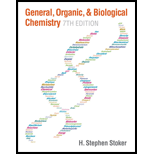
Concept explainers
(a)
Interpretation:
Whether the given statement on a relative scale, density is described as high rather than low describes a
(b)
Interpretation:
Whether the given statement on a relative scale, thermal expansion is described as very small rather than small describes a gas, a liquid, or a solid has to be indicated.
(c)
Interpretation:
Whether the given statement in general, the interactions between particles are very weak (almost zero) describes a gas, a liquid, or a solid has to be indicated.
(d)
Interpretation:
Whether the given statement in general, particles are far apart in a random arrangement describes a gas, a liquid, or a solid has to be indicated.
Trending nowThis is a popular solution!

Chapter 7 Solutions
GENERAL,ORGANIC,+BIO.CHEM.-MINDTAP
- Satellites in space often suffer from vacuum welding, in which two metal parts in contact tend to stick together more than expected over a period of time. Why does this phenomenon occur in space and not on Earth?arrow_forwardWhat are the two ways in which the escape of high-energy molecules from the surface of a liquid during the process of evaporation affects the liquid?arrow_forwardA special vessel (see Fig. 10.45) contains ice and supercooled water (both at 10C) connected by vapor space. Describe what happens to the amounts of ice and water as time passes.arrow_forward
- In terms of the kinetic molecular theory, in what ways are liquids similar to solids? In what ways are liquids different from solids?arrow_forwardConsider the iodine monochloride molecule, ICI. Because chlorine is more electronegative than iodine, this molecule is a dipole. How would you expect iodine monochloride molecules in the gaseous state to orient themselves with respect to each other as the sample is cooled and the molecules begin to aggregate? Sketch the orientation you would expect.arrow_forwardhe following demonstration takes place in a two-step process: rst, solid calcium carbide (CaC2j)reacts with liquid water to produce acetylene gas (C2H2)and aqueous calcium hydroxide. Second the acetylene gas produced is then ignited with a match, causing the combustion reaction of acetylene with oxygen gas to produce gaseous carbon dioxide and gaseous water. Write the balanced equations for each reaction that is occurring, including all phases. If a 100.0gsample of calcium carbide (CaC2)is initially reacted with 50.0gof water, which reactant is limiting? Now imagine that the final gases produced are collected in a large bulkier and allowed to cool to room temperature. Using the information from part b ( l00.0gof Cec2reacting with 50.0gof H2O), how many liters of carbon dioxide gas were produced in the balloon at a pressure of 1.00atm and 25C?arrow_forward
- Although steel is denser than water, a steel needle or paper clip placed carefully lengthwise on the surface of still water can be made to float. Explain at a molecular level how this is possible: Figure 10.67 (credit: Cory Zanker)arrow_forwardIn terms of the kinetic molecular theory, in what ways are liquids similar to gases? In what ways are liquids different from gases?arrow_forwardThe test tubes shown here contain equal amounts of the specified motor oils. Identical metal spheres were dropped at the same time into each of the tubes, and a brief moment later, the spheres had fallen to the heights indicated in the illustration. Rank the motor oils in order of increasing viscosity, and explain your reasoning:arrow_forward
- Mm.26. Subject :- Chemistryarrow_forwardThe measure of the resistance to flow of a liquid isa. London forces. b. van der Waals forces. c. viscosity. d. vapor pressure.e. surface tension.arrow_forwardLiquid A is known to have a lower surface tension and lower vapor pressure than Liquid B. Use these facts to predict the result of each experiment in the table below, if you can. experiment Wax-coated particles carefully put onto the surface of Liquid A or Liquid B will stay on the surface, if the particles are small enough. The heaviest mass of particle m and A mB that will stay on each liquid's surface without sinking are measured. 45.0 mL of Liquid A are put in one sealed 5 L flask, and 45.0 mL of Liquid B are put in another sealed 5 L flask. The pressure in each flask is then slowly lowered with a vacuum pump. predicted outcome m will be greater than mB OmA will be less than mB OmA will be equal to mB It's impossible to predict whether m₁ or MB will be greater without more information. O Eventually both liquids boil, A first and then B. Eventually both liquids boil, B first and then A. ONeither liquid will boil It's impossible to predict whether eitherliquid boils without more…arrow_forward
 General, Organic, and Biological ChemistryChemistryISBN:9781285853918Author:H. Stephen StokerPublisher:Cengage Learning
General, Organic, and Biological ChemistryChemistryISBN:9781285853918Author:H. Stephen StokerPublisher:Cengage Learning Introductory Chemistry: A FoundationChemistryISBN:9781337399425Author:Steven S. Zumdahl, Donald J. DeCostePublisher:Cengage LearningChemistry: Matter and ChangeChemistryISBN:9780078746376Author:Dinah Zike, Laurel Dingrando, Nicholas Hainen, Cheryl WistromPublisher:Glencoe/McGraw-Hill School Pub Co
Introductory Chemistry: A FoundationChemistryISBN:9781337399425Author:Steven S. Zumdahl, Donald J. DeCostePublisher:Cengage LearningChemistry: Matter and ChangeChemistryISBN:9780078746376Author:Dinah Zike, Laurel Dingrando, Nicholas Hainen, Cheryl WistromPublisher:Glencoe/McGraw-Hill School Pub Co Chemistry by OpenStax (2015-05-04)ChemistryISBN:9781938168390Author:Klaus Theopold, Richard H Langley, Paul Flowers, William R. Robinson, Mark BlaserPublisher:OpenStax
Chemistry by OpenStax (2015-05-04)ChemistryISBN:9781938168390Author:Klaus Theopold, Richard H Langley, Paul Flowers, William R. Robinson, Mark BlaserPublisher:OpenStax Chemistry: The Molecular ScienceChemistryISBN:9781285199047Author:John W. Moore, Conrad L. StanitskiPublisher:Cengage Learning
Chemistry: The Molecular ScienceChemistryISBN:9781285199047Author:John W. Moore, Conrad L. StanitskiPublisher:Cengage Learning





